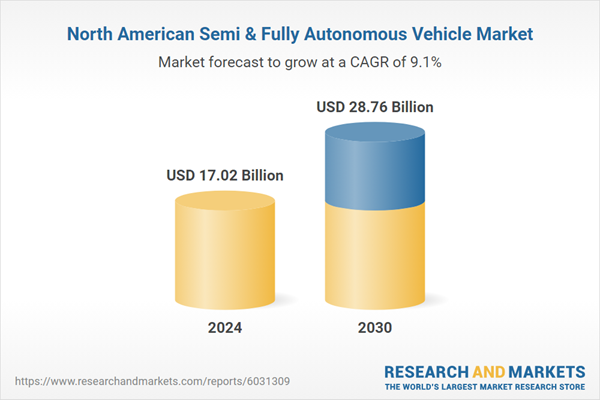Speak directly to the analyst to clarify any post sales queries you may have.
10% Free customizationThis report comes with 10% free customization, enabling you to add data that meets your specific business needs.
North America, known for its advanced infrastructure and high levels of technology adoption, is on the forefront of this revolution in the automotive industry. The region boasts a robust network of charging stations and smart cities that support the integration of autonomous vehicles. Additionally, the presence of major technology hubs and automotive manufacturers further accelerates the development and deployment of autonomous vehicles in the region. Stringent governmental regulations aimed at improving road safety contribute to the growth of the autonomous vehicle market. Policies and standards are being developed to ensure the safe operation of autonomous vehicles on public roads.
These regulations not only protect the public but also encourage companies to invest heavily in the research and development of autonomous vehicles, leading to continuous innovation and improvement in technology. Despite the challenges posed by the need for comprehensive legal frameworks and cyber-security concerns, the future of the North America Semi & Fully Autonomous Vehicle Market looks promising. As technology matures and public acceptance grows, autonomous vehicles have the potential to transform transportation, making it more efficient, sustainable, and safer for everyone on the road.
Key Market Drivers
Technological Advancements
Technological innovation is at the forefront of driving the North American Semi & Fully Autonomous Vehicle Market. Companies in the region, including established automakers, startups, and technology giants, are heavily investing in research and development to advance autonomous technology. Key components such as sensors, artificial intelligence algorithms, and connectivity solutions are continuously evolving. These advancements are paving the way for vehicles to achieve higher levels of autonomy, enabling safer and more reliable autonomous driving experiences.For Instance, In 2022, Daimler Truck, in partnership with its subsidiary Torc Robotics, is at the forefront of developing SAE Level 4 (L4) autonomous trucks with critical redundant safety systems. The companies are testing a fleet of autonomous trucks on public roads in the U.S. and are now collaborating with leading U.S. logistics companies to further develop real-world applications for autonomous trucking. Daimler Truck is committed to commercializing autonomous trucking technology, and addressing the growing demand for freight transport. Further, Daimler Truck North America has also successfully developed the first scalable autonomous truck platform with critical safety systems, based on the Freightliner Cascadia. The autonomous-ready Cascadia has been designed and developed with a second set of critical systems, such as steering and braking, to meet Daimler Truck's uncompromising safety standards.
Key Market Challenges
Technological Complexity and Reliability
Developing and deploying the advanced technology required for semi and fully autonomous vehicles is a complex challenge. These vehicles rely on an array of sensors, cameras, radar, Lidar, and high-definition maps to perceive their surroundings and make real-time decisions. Ensuring the reliability and safety of these systems, especially in diverse weather conditions, is a top priority. Achieving redundancy and fail-safe mechanisms to prevent accidents or malfunctions is an ongoing challenge. Moreover, ensuring the compatibility of autonomous systems with evolving road infrastructure and communication technologies is crucial.Key Market Trends
Advancements in Artificial Intelligence and Machine Learning
Technological advancements in artificial intelligence (AI) and machine learning are at the forefront of the North American autonomous vehicle market. These technologies are essential for enabling vehicles to perceive their surroundings, make real-time decisions, and navigate complex environments. Machine learning algorithms allow autonomous vehicles to improve their performance over time by learning from data and adapting to changing conditions. North American companies and research institutions are leading the way in developing cutting-edge AI solutions that enhance the capabilities and safety of autonomous vehicles.Key Market Players
- BMW North America
- Ford Motor Company
- General Motors (Cruise)
- Honda Motor Co.
- Hyundai Motor Group (including Kia)
- Mercedes-Benz USA
- Stellantis N.V.
- Tesla Inc.
- Toyota Motor North America
- Volkswagen Group of America
Report Scope:
In this report, the North America Semi & Fully Autonomous Vehicle Market has been segmented into the following categories, in addition to the industry trends which have also been detailed below:North America Semi & Fully Autonomous Vehicle Market, By Automation Level:
- L1
- L2
- L3
- L4
- L5
North America Semi & Fully Autonomous Vehicle Market, By Vehicle:
- Passenger Car
- Commercial Vehicle
North America Semi & Fully Autonomous Vehicle Market, By Country:
- Canada
- United States
- Mexico
Competitive Landscape
Company Profiles: Detailed analysis of the major companies present in the North America Semi & Fully Autonomous Vehicle Market.Available Customizations:
With the given market data, the publisher offers customizations according to a company's specific needs. The following customization options are available for the report.Company Information
- Detailed analysis and profiling of additional market players (up to five).
Table of Contents
Companies Mentioned
- BMW North America
- Ford Motor Company
- General Motors (Cruise)
- Honda Motor Co.
- Hyundai Motor Group (including Kia)
- Mercedes-Benz USA
- Stellantis N.V.
- Tesla Inc.
- Toyota Motor North America
- Volkswagen Group of America
Table Information
| Report Attribute | Details |
|---|---|
| No. of Pages | 130 |
| Published | August 2025 |
| Forecast Period | 2024 - 2030 |
| Estimated Market Value ( USD | $ 17.02 Billion |
| Forecasted Market Value ( USD | $ 28.76 Billion |
| Compound Annual Growth Rate | 9.1% |
| Regions Covered | North America |
| No. of Companies Mentioned | 10 |









